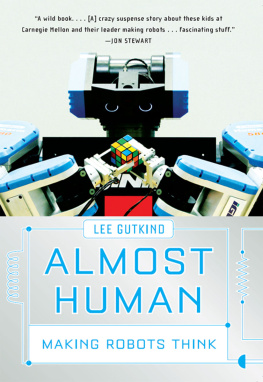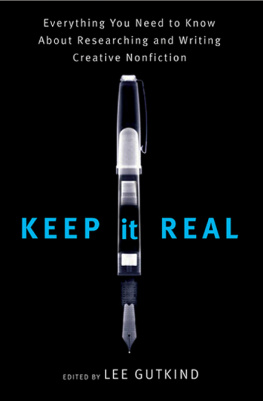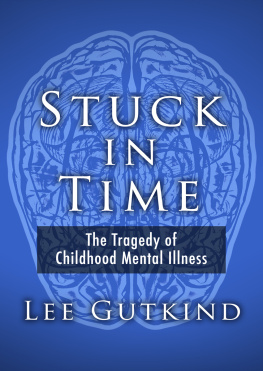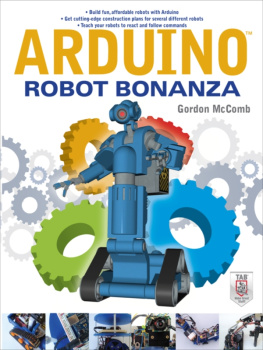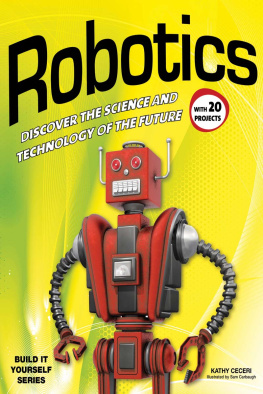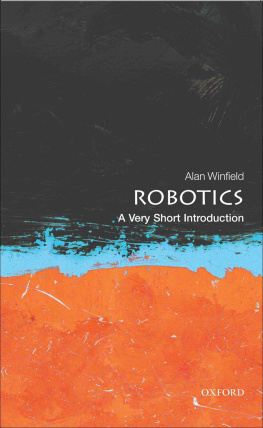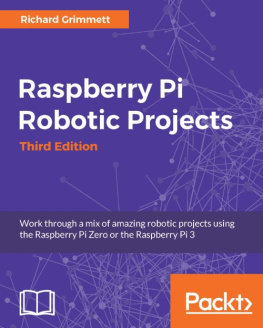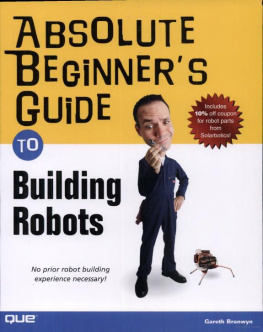almost human
also by Lee Gutkind
IN FACT: THE BEST OF CREATIVE NONFICTION
FOREVER FAT: ESSAYS BY THE GODFATHER
THE VETERINARIANS TOUCH
STUCK IN TIME: THE TRAGEDY OF CHILDHOOD MENTAL ILLNESS
CREATIVE NONFICTION: HOW TO LIVE AND WRITE IT
ONE CHILDRENS PLACE
MANY SLEEPLESS NIGHTS: THE WORLD OF ORGAN TRANSPLANTATION
THE PEOPLE OF PENNS WOODS WEST
THE BEST SEAT IN BASEBALL, BUT YOU HAVE TO STAND!
GODS HELICOPTER (A NOVEL)
BIKE FEVER
almost human
MAKING ROBOTS THINK
Lee Gutkind
W. W. NORTON & COMPANY
NEW YORK LONDON
Copyright 2006 by Lee Gutkind
All rights reserved
For information about permission to reproduce
selections from this book, write to Permissions,
W. W. Norton & Company, Inc.
500 Fifth Avenue, New York, NY 10110
LIBRARY OF CONGRESS CATALOGING-IN-PUBLICATION DATA
Gutkind, Lee.
Almost human: making robots think / Lee Gutkind.
p. cm.
Includes biographical references.
ISBN: 978-0-393-07430-7
1. Autonomous robots. 2. Artificial intelligence. I. Title.
TJ211.495.G88 2007
629. 89263dc22
2006101046
W. W. Norton & Company, Inc.
500 Fifth Avenue, New York, N.Y. 10110
www.wwnorton.com
W. W. Norton & Company Ltd.
Castle House, 75/76 Wells Street, London W1T 3QT
This book is dedicated to my son,
Sam Gutkind,
whose love and loyalty, faith and presence,
inspire and enrich me.
contents
INTRODUCTION
The Rookie Revolution
O VER THE PAST HALF-DOZEN YEARS, OFF AND ON, I have been a fly on the wall at the Carnegie Mellon Robotics Institute in Pittsburgh, witness to a vital new movement coming to life.
What has happened at Carnegie Mellons Robotics Institute during that period changed the shape and scope of the way in which robot technology has evolved. The roboticists at Carnegie Mellon have not only created cutting edge ideas and applications for robots, but they have also embraced and brought together the opposing factions in the robotics worldthe engineers who build the bodies of the robots and the software specialists, the code writers, who help make the robots think. Code means directions written in programming language that intricately translate a robots every conceivable action.
We can credit this accommodation or truce between the hardware/software factions, and the great advances in technology it fostered, partially to Institute leadership. It is a loosely structured operation, with faculty and staff accorded great flexibility and independencean atmosphere that fosters creative freedom and encourages synergistic collaboration within the institution and well beyond it.
But what makes the Robotics Institute unique and, I believe, the reason why the robotics movement is at the tipping point now, is that the proletariatthe studentsshare equally in the process. Students are a strong and vital force behind the creation of the robots produced at Carnegie Mellon. The amazing robots you will meet in this book are primarily the products of the brain and brawn of men and a few women under thirty years of age.
While the technological concepts necessary to make robots think and act are highly sophisticated, a very traditional apprenticeship system is in place in which students or former students learn through on-the-job, hands-on experiences. Young peoplethey are jokingly referred to as rookies or fresh blooddont just do the dirty work, they experience all aspects of the process. There are, as you will see, astounding benefits, along with unfortunate drawbacks, to launching and fortifying a revolution with rookies.
But the robotics world would not be at the tipping point, and we would not be contemplating and initiating interplanetary travel with robots, or robots that compete with humans in soccer, or robots that do science on Mars, or robots that treat patients in hospitals, or robots that engage in realistic conversation with anyone who chooses to speak to them, without the vitality and incredible creativity of the new generation. In the 1990s, computers and the evolving technologyfrom cell phones to video gameschanged the world because of the passion and persistence of young people. Robotics energized by rookies will transform technology again in the twenty-first century.
At Carnegie Mellon graduate students run the gauntlet of evaluation by simply being accepted into this very competitive program, and then allowing themselves to be tossed into the fire and brimstone of the robot tidal wave that obsesses most everyone on the premises. Once you are part of this vortex, the need to succeed, the drive to reach a technological milestone, becomes relentless. The frenetic pace of graduate life is numbing but addictive. Recently, Matt Mason, director of the Robotics Institute, observed of his grad students: They are smart, but nave; you have to be careful not to tell them that the things we are expecting them to do are impossible.
As you will see, Mason wasnt joking. While robots will not soon assume a significant role in society, the advances achieved over the past decade have gone far beyond the expectations of all but the wildest dreamers. Students and freshly minted graduates are the main engines of momentum. Almost Human: Making Robots Think demonstrates how and why this is happening. The future of robotic technology and the power and influence it will yield, is overall, I am pleased to report, in good hands.
PART ONE
the atacama
CHAPTER ONE
Wild Ride to Base Camp
F RANCISCO CALDERON, THE CHILEAN STUDENT AND translater whom everyone calls Finch, is waiting for us at the entrance to the tiny airport in Iquique. Of my traveling companions, Alan Waggoner and Paul Tompkins are veterans of previous Atacama expeditions, while Dom Jonak and I are viewing this eerie landscape for the first time. Jonak and Tompkins are from the Robotics Institute at Carnegie Mellon University in Pittsburgh while Waggoner directs the Molecular Biosensor and Imaging Center (MBIC) at Carnegie Mellon.
The Atacama Desert stretches from the Peruvian border south in a narrow band 600 miles into northern Chile. With its dazzling white salt flats and vast expanses of rusty-red emptiness, the Atacama is the driest place on Earth, a place climatologists call absolute desert. Death Valley in California and the Gobi Desert in Mongolia get anywhere from three to six times more moisture annually than the Atacama. Obviously, there are very few living organisms in this desert, which makes the Atacama an ideal analog to Mars. Seeking life on Mars is an ongoing obsession of many of the scientists and software engineers at Carnegie Mellon and the National Aeronautics and Space Administration (NASA), a frequent partner.
We pile our bags into the bed of the double cab Toyota HiLux pickup, a sturdier version of the Toyota Tacoma we use in the United States. The HiLux, an Action Utility Vehicle (AUV) according to Toyota, is aptly named because of its capacity to endure constant, violent, and aggressive abuse. They are perfect for the terrain and also for the crazed, explosive spirit with which the roboticists drive when unleashed in the wilds with a vehicle built for battering. The programmers frustration of sitting behind a computer and writing and struggling endlessly with code is released in this desertwith passion. Soon, we are rocketing out onto this sun-scorched plain.
The road from the airport into the desert is smooth, and the terrain is flat and red, with white misshapen clumps of salt dotting the landscape to the west where we are headed. They look like gigantic white fat globules, glittering, almost oozing, in the sun. We can see the distant bejeweled reflection of the ocean off to one side, a rather disconcerting sight, considering the barrenness of the landscape surrounding us. Although it does not form rain, the moisture contained in the thick dense fog from the ocean seeping above the mountains allows some organisms to survive. We will be seeking those organisms at Salar Grande, the location of our base camp, less than an hour away. Iquiquethe name comes from the Aymara (a native Andean ethnic group) word that translates to lazinessis a tourist stop popular for its surf and beaches and its architecture. Theres also a bustling commercial port area to service the copper and salt unearthed from mines in the desert.

